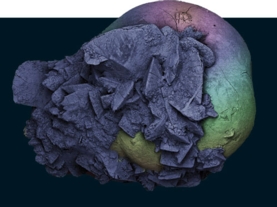When the kidney does not properly eliminate salts and minerals, those waste products can grow into the small, agonizing pellets known as kidney stones. Roughly one in 11 Americans develops them—a rate that has doubled over the past two decades as a result, in part, of our obesity epidemic. About the size of a grape seed, this stone passed through the ureter of its owner naturally.
The false-colored scanning electron microscope image (magnified 50×) depicts the stone in grisly detail, with smooth calcium oxalate monohydrate crystals overgrown with jagged dehydrate crystals. Not all kidney stones escape easily: some grow so large that they block urinary flow and require medical intervention.
The most common way to get rid of them is shock wave lithotripsy, a noninvasive technique in which high-frequency shock waves directed at the stone generate enough pressure to shatter it into tiny, sandlike fragments. This spring a team of urologists, engineers and mathematicians at Duke University improved on the technique. The researchers cut a small groove in the lens that focuses the shock waves and found that the simple adjustment optimizes wave shape so that the procedure is more accurate and minimizes damage to surrounding body tissues. It is a relatively cheap, straightforward innovation that may soon help treat millions of kidney stone patients worldwide.
Source: Scientific American

